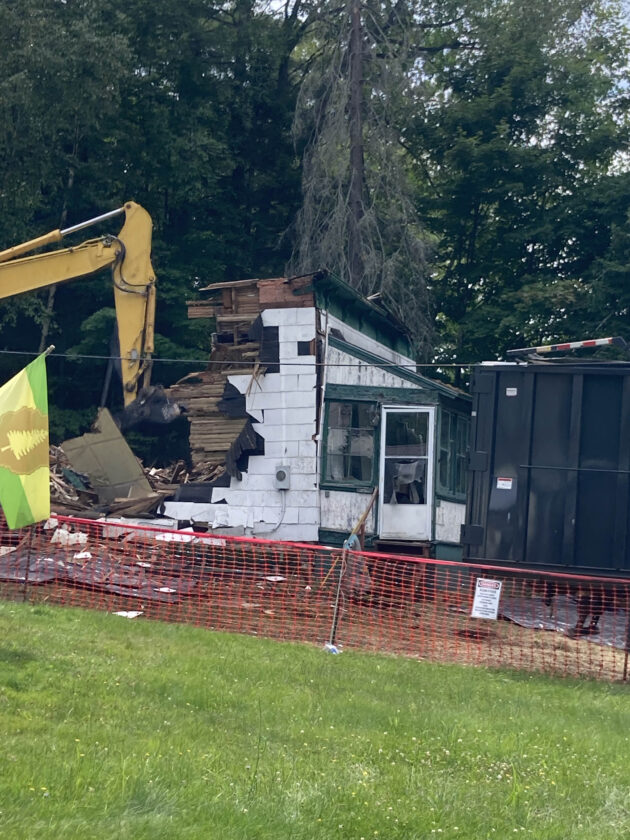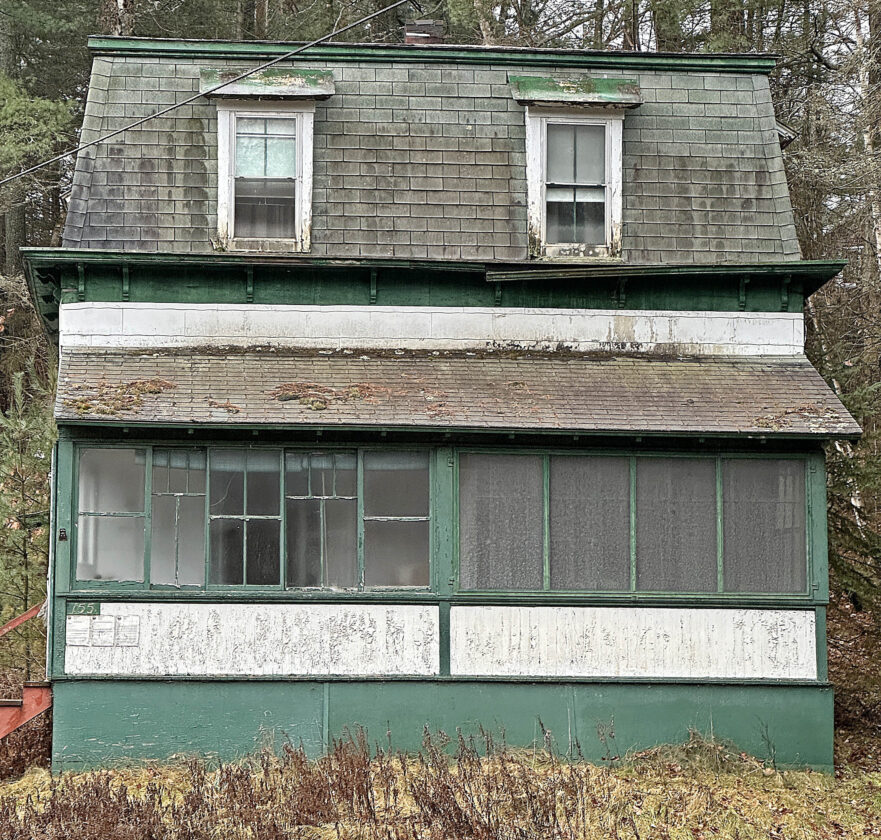Home, home on the brook
- A house at 34 Brandy Brook Ave. was demolished last Thursday as the Essex County Land Bank plans to turn the long-vacant property into affordable housing. (Provided photo — Barbara Kent)
- A house at 34 Brandy Brook Ave. was demolished last Thursday as the Essex County Land Bank plans to turn the long-vacant property into affordable housing. (Provided photo — Essex County Land Bank)
- A CrossMod house in Newcomb was recently built by the Essex County Land Bank. This project model is expected to be replicated at a property on Brandy Brook Avenue in Saranac Lake. (Provided photo — Essex County Land Bank)

A house at 34 Brandy Brook Ave. was demolished last Thursday as the Essex County Land Bank plans to turn the long-vacant property into affordable housing. (Provided photo — Barbara Kent)
SARANAC LAKE — A long-vacant house on Brandy Brook Avenue was demolished last week, and the Essex County Land Bank plans to build a new, affordable home in its place within the next year.
The property at 34 Brandy Brook Ave. has been vacant since the early 2010s, was foreclosed on in 2014 and defaulted to county ownership in 2019.
In January 2024, the county donated the property to the land bank.
The foreclosed property had been eyed by the town of North Elba at least as far back as 2023, before the Essex County Land Bank had been formally created.
A land bank is an entity separate from the county, which works with the county to take properties that have years of delinquent taxes and are run-down or vacant, and transfers them to the land bank. The land bank renovates the property with state grants and private money and sells it to private people for housing or commercial use, putting the land back on the tax rolls.

A house at 34 Brandy Brook Ave. was demolished last Thursday as the Essex County Land Bank plans to turn the long-vacant property into affordable housing. (Provided photo — Essex County Land Bank)
–
Plan for the home
–
Essex County Land Bank Executive Director Nicole Justice Green said the land bank won’t build a duplex as originally planned. It would be larger than the original house footprint, subjecting it to new setback requirements from the state Department of Environmental Conservation, which would put it too close to a culvert in the front yard. It would also be more expensive and require heavy equipment to build, causing it to be difficult to get over the culvert.
Instead, the land bank is working with Champion homes in Sangerfield to place a new energy-efficient “CrossMod” home at the site.

A CrossMod house in Newcomb was recently built by the Essex County Land Bank. This project model is expected to be replicated at a property on Brandy Brook Avenue in Saranac Lake. (Provided photo — Essex County Land Bank)
“While all CrossMods are modular in construction, not all modular homes are CrossMods, and the distinction lies in the higher design and financing standards that CrossMods are required to meet,” Green said. “The cost of fabrication of these homes is pretty low compared to traditional modular construction, but not compromising on the quality.”
The land bank was part of a pilot program recently to place a CrossMod home in Newcomb, and because the pilot was deemed successful, the state earmarked funds for the land bank to replicate that project elsewhere in the county.
The CrossMod pilot in Newcomb placed a three-bedroom, two-bath house with a detached garage at a cost of $260,000, Green said. The land bank will be selling the home for $150,000 to $175,000, she added. The Brandy Brook property is unlikely to be more expensive, she said, except potentially the culvert and site work.
The land bank will have to act soon on Brandy Brook. Green said they need to place a home within 12 months or be subject to pretty strict setback requirements from the DEC. These would make it difficult to place a home there, due to the proximity to the culvert.
“It is a somewhat expedited process,” Green said.
She said they plan to place the home in the spring if all goes well.
The property is right next to the Adirondack Rail Trail and near the village downtown.
–
No tax dollars
–
The land bank has applied for a grant, Green said, and can move forward after that funding is secured.
She said people sometimes ask her why tax dollars are going into housing development. She said they aren’t. These projects aren’t funded by tax dollars.
All funding comes from the state Homes and Community Renewal agency’s land bank initiative funding. This is funded by the state Housing Trust Fund Corporation. The corporation is funded by mortgage tax recording fees and a number of billion-dollar settlements with financial corporations from the subprime mortgage crisis they caused in the late 2000s.
The state took the money from these settlements with banks like with JPMorgan Chase, Bank of America, Citigroup, Goldman Sachs and Morgan Stanley and put it in the HTFC to grow interest and fund housing programs.
“These settlement dollars formed the foundation of HTFC’s programs, ensuring that those responsible for the crisis directly funded the state’s housing response,” Green said.
–
‘Tears from heaven’
–
The house was once home to members of the Moody family, some of the earliest Saranac Lake residents, and was across the street from the original Moody homestead.
Barbara Kent, who lives next to the house, was sad to see it demolished. The house was not on a historic registry, but it was eligible, she said.
Kent took care of its last occupant, Molly Handley, for many years.
“She kept that house immaculate,” Kent said. “She swept the cellar every day. You could have eaten off of any floor in that house any day.”
Molly died in 2011. The house has been vacant since.
“When they started taking it down … all of a sudden it started raining,” Kent said. “I’m like, those are tears from heaven.”
Green, a self-described “recovering historian,” said she recognized the historic value of the house there, but that, unfortunately, it was not feasible to restore it while remaining affordable.
“It would have cost $500,000 to $600,000 to save that building,” Green said.
That’s money the land bank could spend on restoring several other homes, she added.
“There was literally a family of raccoons in it,” Green said.
There was a hole from ceiling into the foundation, it was structurally unsound and beginning to cave in on itself, she said.
–
Land banks and CrossMods
–
Green described the land bank as an “extra arm” of the Essex County government. It relies on land donations to turn blighted properties into homes.
“It’s a really powerful tool and I wish more counties would take advantage of it,” Green said.
Land banks have “unique powers” given by the state’s land bank act passed in 2011. Other developers or nonprofits would have to pay fair market value for the property and pay taxes on it while they redevelop it.
The full property was tentatively assessed at $103,200 in 2025 with an estimated full market value of $103,200.
Green thanked the county, as well as the North Elba town council and Supervisor Derek Doty for donating the land for free. She also thanked Saranac Lake’s code enforcement officer and zoning officer for assisting in the process.
The Essex County Land Bank is part of the 41-year-old North Country Rural Development Corporation. Though the land bank is new, Green said its connection to the corporation gives it administrative depth, institutional knowledge and credibility.
She said they have a great staff. They’ve done 23 home replacements and gut rehabs this year through NCRDC and five demolitions and four completed homes through land bank in two years.
The cities of Schenectady and Syracuse were also in the CrossMod pilot. Essex County’s pilot in Newcomb was the only rural one, but Green was proud to be first to complete the home out of the three.
“A traditional modular home is factory-built in sections, transported to the site and set on a permanent foundation,” Green said. “The design and appearance of modular homes can vary, and in some cases they may still be perceived by lenders or buyers as closer to manufactured housing, which can affect financing or resale.
“CrossMod homes are different in that they are a newer (U.S. Department of Housing and Urban Development)-recognized category specifically created to overcome these barriers,” she added. “Built to HUD code, they must also include a permanent foundation and a set of site-built-style features — such as a steeper roof pitch with eaves, drywall interiors instead of paneling, energy-efficient standards and a permanent porch, garage or carport — that make them virtually indistinguishable from traditional site-built homes.”
This makes CrossMod homes qualify for special financing programs which provide more favorable mortgage rates, better appraisal comparables and stronger resale potential, Green said.
She added that the state noticed the unique housing crisis in the Adirondack Park because the extra layer of development regulation makes building housing extra difficult. Development can only really happen in the small hamlets of the park.





